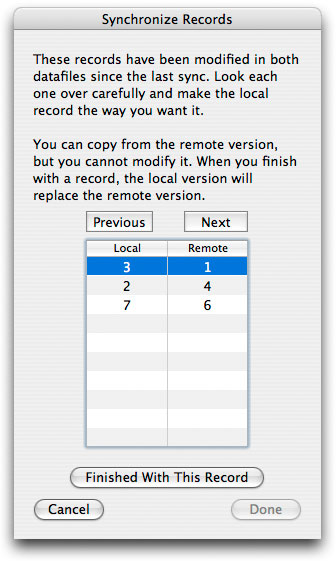Between a Mac and Apple Mobile Devices
iData Pro provides two methods for
synchronizing datafiles on the Mac with datafiles on the iPhone,
iPod Touch, and iPad. (To keep things simple, we will just refer
to the iPhone below.)
The simplest method is via a local
WiFi network, created using a wireless router, such as Airport
Extreme. This is the method of choice for a single individual
who just needs to keep datafiles on both platforms in sync.
If you need to synchronize when the iPhone is outside the range of the WiFi network, another possibility is to subscribe to Dropbox, which is a commercial file storage service. iData Pro can synchronize to datafiles stored in an iData folder in the Dropbox Apps folder. This option is useful mainly when one individual is using iData Pro on the Mac, while another is using iData Mobile or iData Mobile Plus on the iPhone, because it requires that actions be taken on both platforms.
| NOTE: iData Pro can open two kinds of
datafiles: 1. iData 3-style datafiles, having an .id3 file name extension: These datafiles can have multi-styled text and embeded images in the Freeform Text Area. 2. iData Mobile-style datafiles, having an .idm file name extension: These datafiles can have only mono-styled text in the Freeform Text Area. From its beginning, iData Pro could synchronize datafiles that had an .idm file name extension to the original iData Mobile. However, iData Mobile will not run under 64-bit versions of iOS, so it is no longer supported. Beginning with version 4.0.19, iData Pro can also synchronize datafiles with an .id3 file name extension to the newer iData Mobile Plus. When a WiFi connection is made to either mobile app, iData Pro can recognize which one it is connected to, and it will synchronize only the appropriate kind of datafile for that mobile app. This means that iData Pro will not synchronize .id3 datafiles to iData Mobile, and will not synchronize .idm datafiles to iData Mobile Plus. Since both mobile apps handle things in the same way, we'll just refer to "iData Mobile Plus" in the following text. |
Creating a New Sync File on the iPhone Over a Local WiFi Network
1. Open iData
Mobile Plus on the iPhone. Be sure that WiFi is turned on, and a
WiFi network is selected in the iPhone Settings application.
2. Tap the  icon in the toolbar at the bottom of the Datafiles
window.
icon in the toolbar at the bottom of the Datafiles
window.
3. In the next
window, tap the WiFi
Synchronization button. This will bring up the
following window.

4. Note that the
top line in this window says, "No WiFi Connection". If you see
this line, it means that your iPhone does not have a good WiFi
connection. Once the WiFi connection is good, you will see that
it now says "Starting Connection". At that point, you can
proceed with synchronization.
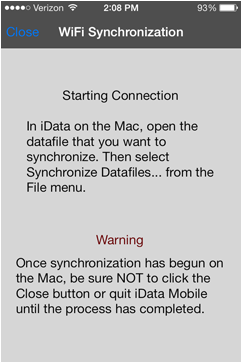
5. Leave this
window open until you finish creating your sync file. (You can
create as many sync files as you wish while this window remains
open.)
6.
Open
the datafile to be synced in iData Pro. If this is a datafile
that does not already contain a Sync ID, iData Pro will assume
that you want to create a sync file to match it.
NOTE
1: This datafile must be in the correct format, as
explained in the NOTE above.
NOTE
2: Memory is extremely limited on the iPhone. We
strongly recommend that you do not try to use datafiles any
larger than 5 MB in size. If you start to create a sync file
that is larger that 5 MB, you will see a warning notice, and
will have a chance to cancel the process. Then you can try to
reduce the size of the datafile. iData Pro provides a function
to split a datafile into two smaller datafiles, but if you are
creating datafiles from scratch, you are probably better off
just being careful not to exceed this file size.
7.
Choose
Save As New Sync File... from the File menu, read the text in the
dialog sheet that comes up, and click the OK button.
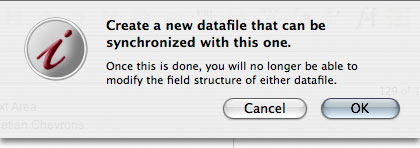
8. Next you will be asked how you want to create the sync file. When the following dialog appears, you can enable the Always use this synchronization method checkbox to avoid this dialog in the future. (This option can be changed at any time in the Special tab of the iData Pro Preferences dialog.)
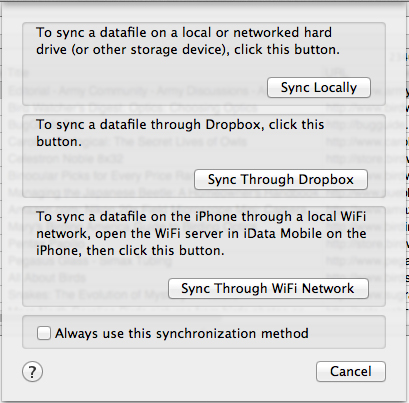
10. If you have multiple active WiFi devices, you may see the following dialog. In it, select your iPhone, then click the OK button.

NOTE iData will remember the name of the iPhone that you select, and will use it in the future if it is available. If it is not available, this dialog will appear again.
11. At this point, an "Uploading" progress sheet will open at the top of the datafile window on the Mac. When the sheet closes, the WiFi Synchronization window in iData Mobile Plus will say, "File Uploaded". At this point, you can tap the Close button in the WiFi Synchronization window in iData Mobile Plus, and your datafile will appear in the Datafiles list.
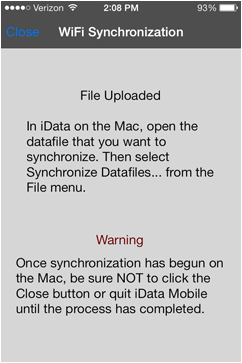
Synchronizing a Pair of Sync Files Over the WiFi Network
Once a sync file has been created on the iPhone, you can make
changes to it and/or to the original on the Mac. When you want
to get both datafiles to match again, you can perform
synchronization. The process is very similar to what you did
to create the sync file in the first place.
1. Open iData Mobile Plus on the iPhone. Be sure
that WiFi is turned on, and a WiFi network is selected in the
iPhone Settings application.
2. Tap
the  icon in the toolbar at the bottom of
the Datafiles window.
icon in the toolbar at the bottom of
the Datafiles window.
3. In the next
window, tap the WiFi
Synchronization button. This will bring up the
following window.

4. Note the
address beginning with http at the bottom of the window. As
explained in the previous section, if this window says "No
WiFi Connection, you will have to make sure that you have a
good WiFi connection before proceeding.
5. Leave this
window open until you finish syncing on the Mac side. (You can
synchronize as many datafiles as you wish while this window
remains open.)
Note: If the current (frontmost) datafile does not have a Sync ID, then both the Synchronize Datafiles... and Remove Sync ID... items under the File menu will be disabled.
7. Choose Synchronize Datafiles... from the File menu. When the following dialog appears, click the Sync Through WiFi Network button.

8. If you have multiple active WiFi devices, you may see the following dialog. In it, select your iPhone, then click the OK button.

9. At this point, a "Downloading" progress sheet will open at the top of the datafile window. The message will briefly change to "Synchronizing". If there are no cases of the same record having been modified in both datafiles, the message will then change to "Uploading". When the sheet closes, you can tap the Close button in the WiFi Synchronization window in iData Mobile Plus, and your datafile will be identical on both platforms.
See the section on Manual Synchronization, below, to learn how iData Pro allows you to resolve those cases where changes have been made to the same record in both datafiles.
Creating a New Sync File on Dropbox
1. Open the datafile to be synced in iData Pro. If this
is a datafile that does not already contain a Sync ID, iData Pro
will assume that you want to create a sync file to match it.
NOTE:
Memory is extremely limited on the iPhone. We strongly recommend
that you do not try to use datafiles any larger than 5 MB in
size. If you start to create a sync file that is larger that 5
MB, you will see a warning notice, and will have a chance to
cancel the process. Then you can try to reduce the size of the
datafile. iData Pro provides a function to split a datafile into
two smaller datafiles, but if you are creating datafiles from
scratch, you are probably better off just being careful not to
exceed this file size.
2.
Choose
Create A New Sync File... from the File menu, read the text in the
dialog sheet that comes up, and click the OK button.

3. Next you will be asked how you want to create the sync file. When the following dialog appears, click the Sync Through Dropbox button. When the following dialog appears, you can enable the Always use this synchronization method checkbox to avoid this dialog in the future. (This option can be changed at any time in the Special tab of the iData Pro Preferences dialog.)

4. At this point, a "Synchronizing" progress sheet will open at the top of the datafile window. When the sheet closes, your datafile will appear in the iData folder within the Apps folder in Dropbox.
NOTE: The first time you do this, the Dropbox sign-in page will open, and you will be asked to sign in and then comfirm that it's okay to create an iData folder in your Dropbox. At that point, you will have to repeat this process one more time. Once the iData folder has been created, the following dialog will come up:
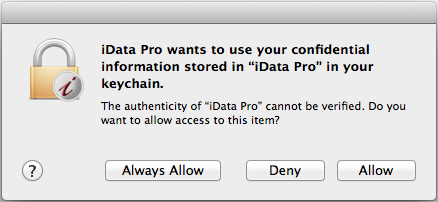
If you don't want to see this dialog every time you synchronize a datafile to Dropbox, simply click the Always Allow button. Otherwise, click the Allow button.
Synchronizing a Pair of Sync Files via Dropbox
When synchronizing a datafile stored on Dropbox, iData Pro and iData Mobile Plus perform different roles. If it is to be successful, careful coordination between the Mac user and the iPhone user is required.
The workflow is as follows:
1. The iData Mobile Plus user must save any changes to the datafile to Dropbox.
2. The iData Pro user then synchronizes the Mac version of the datafile to the one on Dropbox.
3. Finally, the iData Mobile Plus user downloads the synchronized version of the datafile from Dropbox.
Here are the steps involved.
1. If the iData Mobile Plus version of the datafile has been changed since the last sync, save it to Dropbox. See the iData Mobile Plus User Guide for instructions.
2. . Open the Mac version of the datafile in iData Pro.
Note: If the current (frontmost) datafile does not have a Sync ID, then both the Synchronize Datafiles... and Remove Sync ID... items under the File menu will be disabled.
3. Choose Synchronize Datafiles... from the File menu. When the following dialog appears, click the Sync Through Dropbox button.

4. At this point, a "Downloading" progress sheet will open at the top of the datafile window. The message will briefly change to "Synchronizing". If there are no cases of the same record having been modified in both datafiles, the message will then change to "Uploading". When the sheet closes, the datafile on the Mac and the one in Dropbox will be identical.
See the section on Manual Synchronization, below, to learn how iData Pro allows you to resolve those cases where changes have been made to the same record in both datafiles.
5. Once the
synchronization process has been completed, the iData Mobile
Plus user must read the modified datafile from Dropbox. See the
iData Mobile Plus User Guide for instructions.

